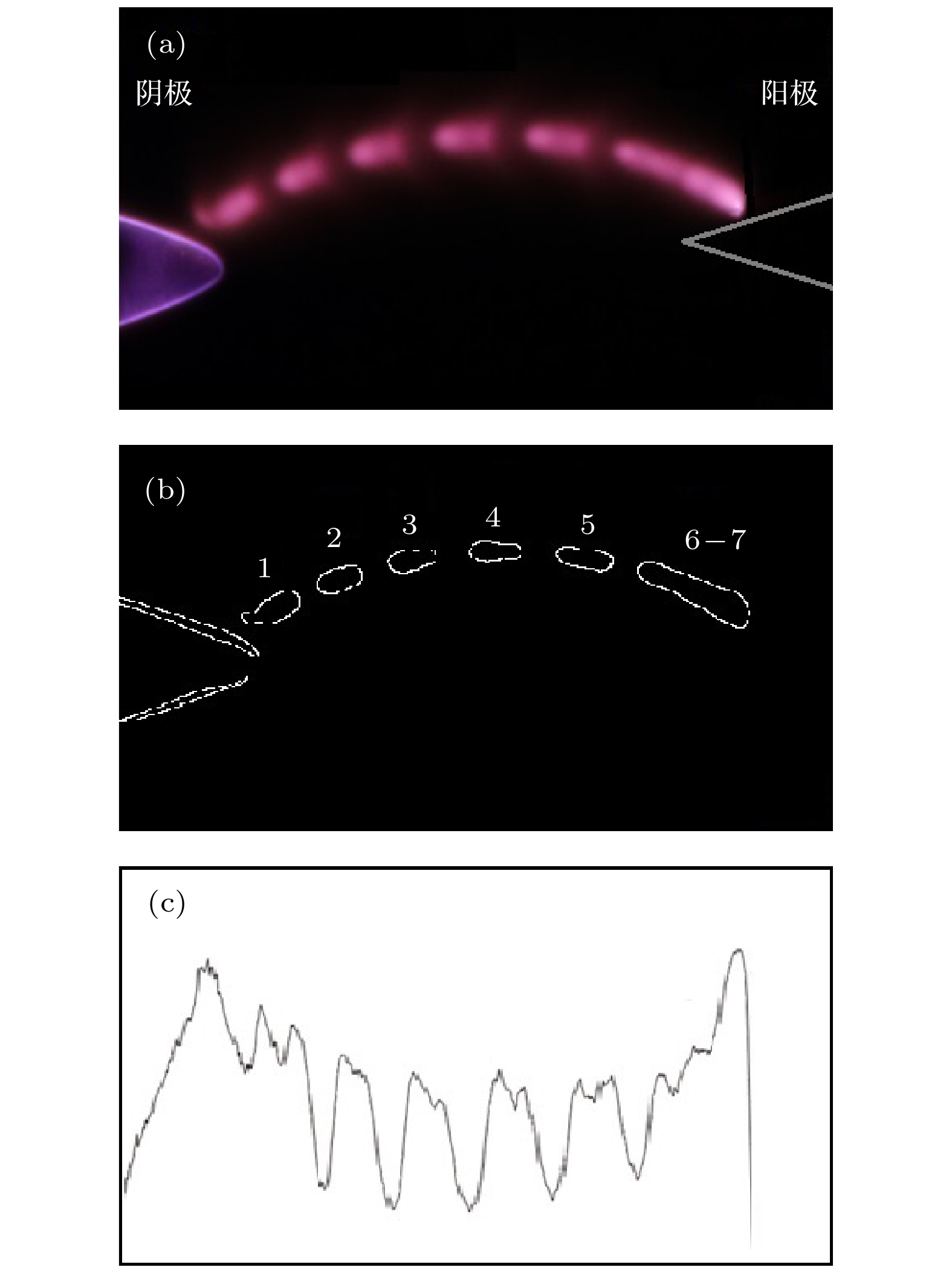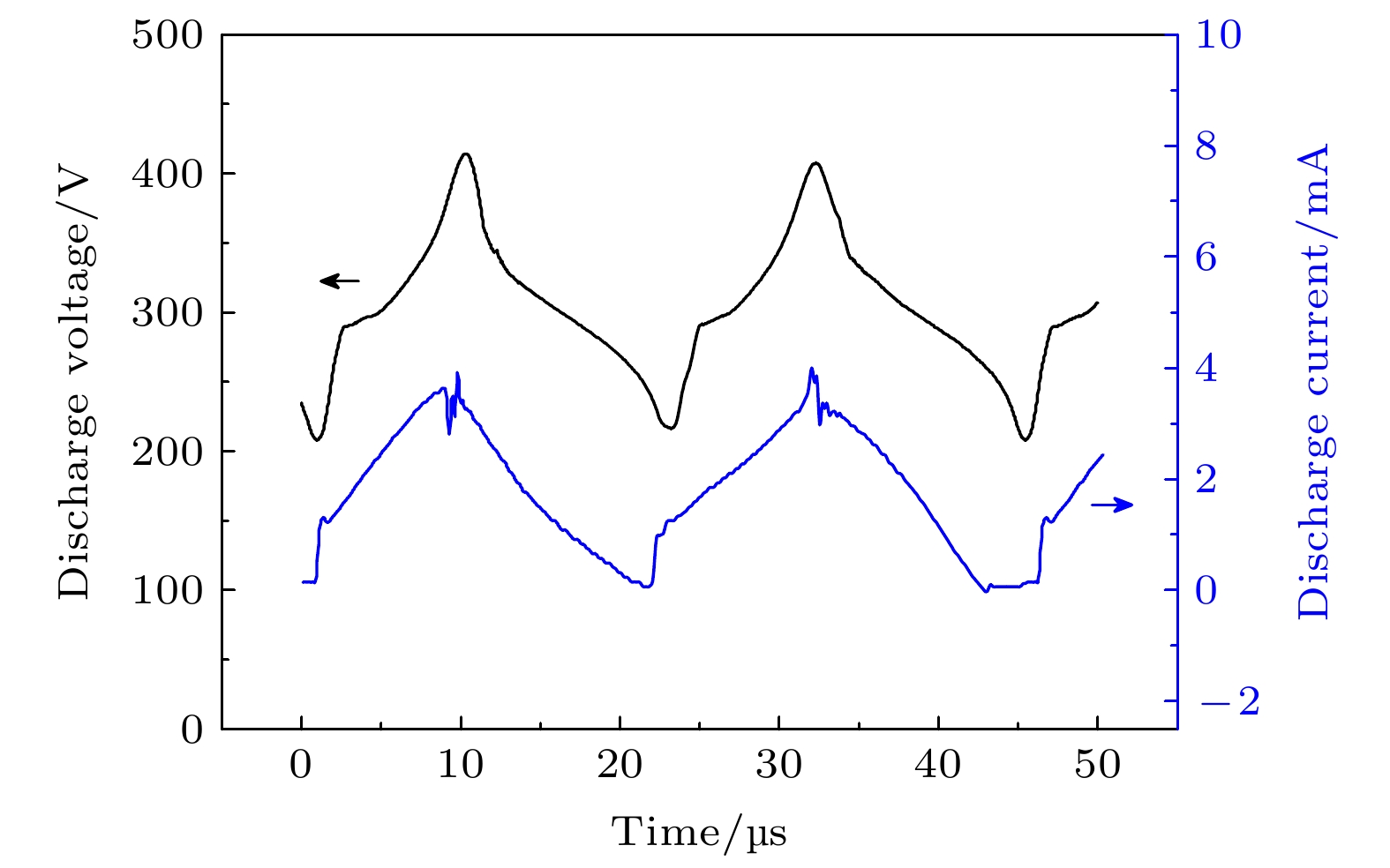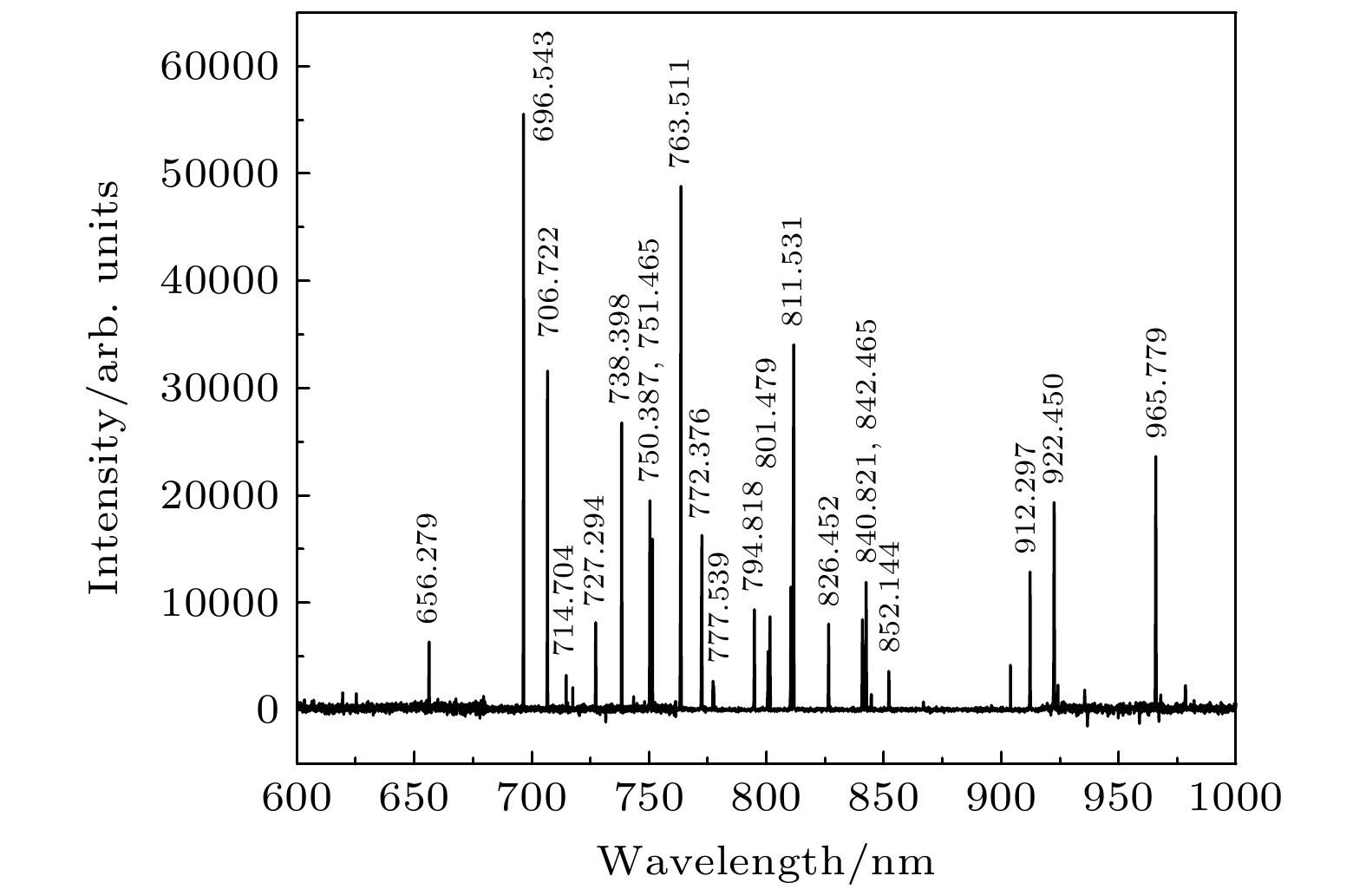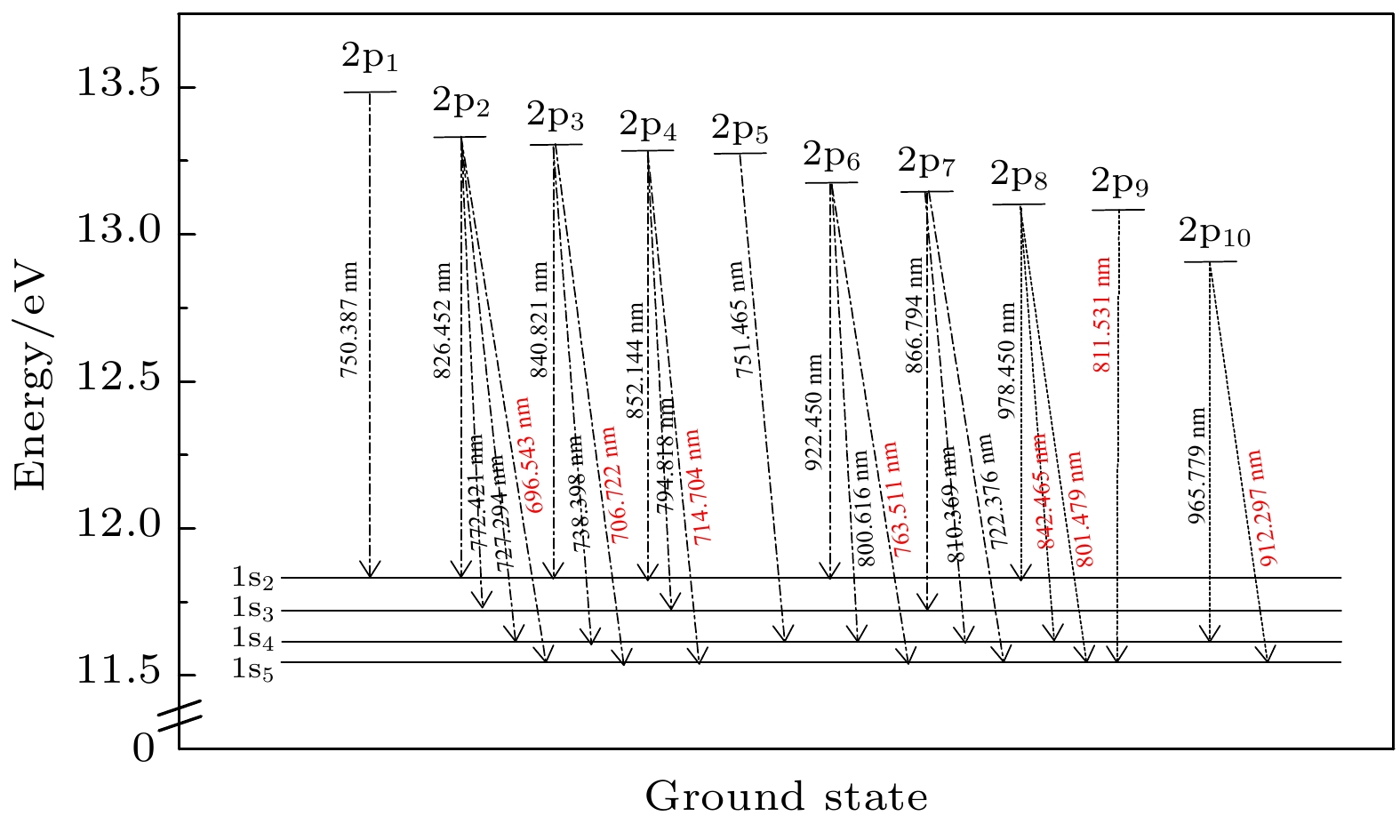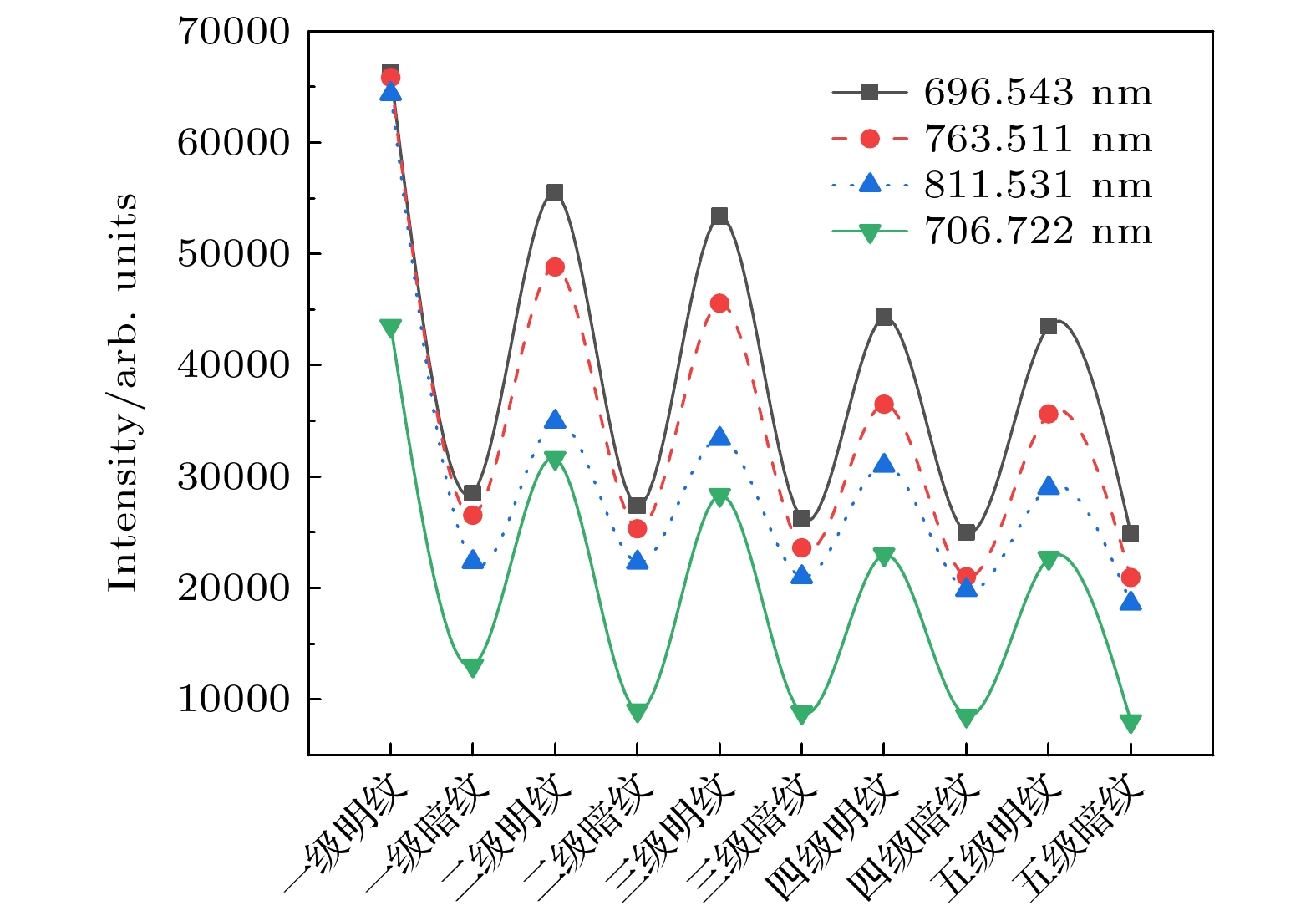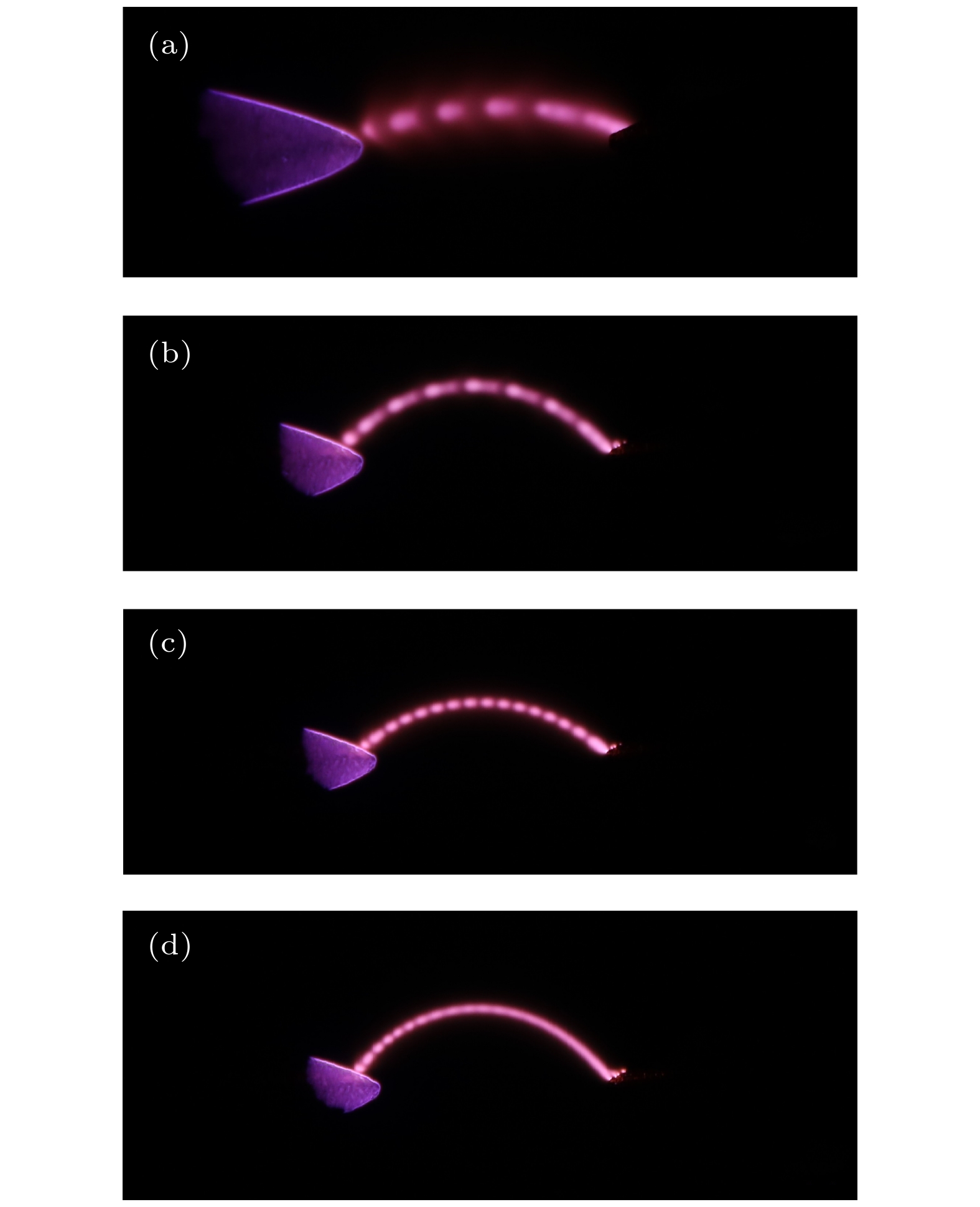-
辉光放电等离子体正柱区内的自组织条纹现象是气体放电物理中的基础性问题, 涉及电子动力学、输运过程、放电不稳定性、非线性现象等丰富的物理内容, 是基础物理及其应用中备受关注的重要课题. 本文报道了一种在千帕量级气压下产生的氩气辉光放电条纹等离子体, 重点关注了条纹等离子体的电学、光学及电离波传播特征, 从物理上分析了氩气条纹等离子体的产生及消除机制. 研究结果表明, 在此气压下产生的氩气条纹等离子体, 其条纹长度约为1.5 mm, 且随气压减小; 电离波波速为1.87 m/s, 频率为1.25 kHz. 发射光谱诊断证实, 条纹等离子体的产生与丰富的亚稳态原子密切相关, 亚稳态原子导致的分步电离过程会引起电离不稳定性, 这种不稳定性以电离波的形式传播, 使得等离子体参数发生纵向调幅, 从而形成明暗相间的条纹等离子体. 加入氮气可有效猝灭亚稳态氩原子, 调整电子能量分布函数, 这使得等离子体的不稳定性条件被破坏, 因此, 条纹等离子体消失. 本工作可为人们进一步认识和理解高气压下辉光放电条纹等离子体的形成及消除机制提供新的思路和实验依据.The self-organized striation phenomenon in the positive column region of glow discharge plasma is a basic problem in gas discharge physics, which involves rich physics such as electron dynamics, transport process, discharge instability and nonlinear phenomenon. It is an important topic in basic physics and practical application. In this work an argon glow discharge striation plasma at high pressure is reported. The electrical, optical and ionization wave propagation characteristics of the striation plasma, and the evolution of the striation plasma with pressure and impurity gas are investigated experimentally. The generation and quenching mechanism of argon striation plasma are analyzed. The results show that the striation length is about 1.5 mm, and decreases with pressure increasing, and the velocity and frequency of the ionization wave are estimated at 1.87 m/s and 1.25 kHz, respectively. The measurement of optical emission spectrum shows that the generation of striation plasma is probably related to the argon metastable atoms. The stepwise ionization process caused by metastable atoms triggers off an ionization instability. The instability propagates in the form of ionization wave, which leads the plasma parameters to be modulated longitudinally, thus, forming an alternating bright and dark striation plasma. The adding of nitrogen can effectively quench metastable argon atoms and change the electron energy distribution function, which destroys the instability conditions of the plasma, therefore, the striation plasma disappears. This work provides a new insight into the understanding of the formation and annihilation mechanism of glow discharge striation plasma at high pressure.
-
Keywords:
- glow discharges /
- striation plasmas /
- ionization instability /
- ionization wave /
- optical emission spectrometry.
[1] Bogaerts A 1999 J. Anal. At. Spectrom. 14 1375
 Google Scholar
Google Scholar
[2] Kiselev A S, Menshchikova V V, Seyfulina N A, Smirnov E A 2019 J. Phys. Conf. Ser. 1313 012030
 Google Scholar
Google Scholar
[3] Long L, Zhou W X, Tang J F, Zhou D S 2020 Plasma Process. Polym. 17 1900242
 Google Scholar
Google Scholar
[4] Ezhovskii Y K, Mikhailovskii S V 2019 Russ. Microelectron. 48 229
 Google Scholar
Google Scholar
[5] Raizer Y P 1991 Gas Discharge Physics (Berlin: Springer) p230
[6] Kolobov V I 2006 J. Phys. D Appl. Phys. 39 R487
 Google Scholar
Google Scholar
[7] Pollard W, Suzuki P, Staack D 2014 IEEE Trans. Plasma Sci. 42 2650
 Google Scholar
Google Scholar
[8] Mulders H C J, Brok W J M, Stoffels W W 2008 IEEE Trans. Plasma Sci. 36 1380
 Google Scholar
Google Scholar
[9] Mahamud R, Farouk T, Kolobov V 2017 The 44th International Conference on Plasma Science Atlantic City, American, May 21–24, 2017
[10] Lisovskiy V A, Koval V A, Artushenko E P, Yegorenkov V D 2012 V Eur. J. Phys. 33 1537
[11] Keys D A, Heard J F 1930 Nature 125 971
 Google Scholar
Google Scholar
[12] Tsendin L D 2009 Plasma Sources Sci. Technol. 18 014020
 Google Scholar
Google Scholar
[13] Novák M 1960 Czech. J. Phys. B 10 954
 Google Scholar
Google Scholar
[14] Zhu W Y, Cui R L, He F, Wang Y Q, Ouyang J T 2021 Phys. Plasmas 28 113502
 Google Scholar
Google Scholar
[15] Levko D 2021 Phys. Plasmas 28 013506
 Google Scholar
Google Scholar
[16] Golubovskii Y B, Nekuchaev V O, Skoblo A Y 2014 Tech. Phys. 59 1787
 Google Scholar
Google Scholar
[17] Golubovskii Y, Gurkova T, Valin S 2021 Plasma Sources Sci. Technol. 30 115001
 Google Scholar
Google Scholar
[18] Godyak V A, Alexandrovich B M, Kolobov V I 2019 Phys. Plasmas 26 033504
 Google Scholar
Google Scholar
[19] 王建龙, 丁芳, 朱晓东 2015 物理学报 64 045206
 Google Scholar
Google Scholar
Wang J L, Ding F, Zhu X D 2015 Acta Phys. Sin. 64 045206
 Google Scholar
Google Scholar
[20] Shkurenkov I A, Mankelevich Y A, Rakhimova T V 2009 Phys. Rev. E 79 046406
 Google Scholar
Google Scholar
[21] Golubovskii Y, Valin S, Pelyukhova E, Nekuchaev V 2019 Plasma Sources Sci. Technol. 28 45015
 Google Scholar
Google Scholar
[22] Golubovskii Y B, Siasko A V, Kalanov D V, Nekuchaev V O 2018 Plasma Sources Sci. Technol. 27 085009
 Google Scholar
Google Scholar
[23] Hodgman S S, Dall R G, Byron L J, Baldwin K G H, Buckman S J, Truscott A G 2009 Phys. Rev. Lett. 103 053002
 Google Scholar
Google Scholar
[24] Johnston P D, 1971 Phys. Lett. A 34 389
[25] Siefert N S, Sands B L, Ganguly B N 2006 Appl. Phys. Lett. 89 011502
 Google Scholar
Google Scholar
[26] Yamada H, Kato S, Shimizu T, Fujiwara M, Fujiwara Y, Kim J, Ikehara S, Shimizu N, Ikehara Y, Sakakita H 2020 Phys. Plasmas 27 022107
 Google Scholar
Google Scholar
[27] Morgan W L, Childs M W 2015 Plasma Sources Sci. Technol. 24 55022
 Google Scholar
Google Scholar
[28] Liu Y X, Schüngel E, Korolov I, Donkó Z, Wang Y N, Schulze J 2016 Phys. Rev. Lett. 116 255002
 Google Scholar
Google Scholar
[29] Iza F, Hopwood J A 2005 IEEE Trans. Plasma Sci. 33 306
 Google Scholar
Google Scholar
[30] Zhu H, Su Z, Dong Y 2017 Appl. Phys. Lett. 111 054104
 Google Scholar
Google Scholar
[31] Golubovskii Yu B, Siasko A V, Nekuchaev V O 2020 Plasma Sources Sci. Technol. 29 065020
 Google Scholar
Google Scholar
[32] Kabouzi Y, Calzada M D, Moisan M, Tran K C, Trassy C 2002 J. Appl. Phys. 91 1008
 Google Scholar
Google Scholar
[33] Czerwiec T, Graves D B 2004 J. Phys. D: Appl. Phys. 37 2827
 Google Scholar
Google Scholar
[34] Kawamura E, Lieberman M A, Lichtenberg A J 2019 Phys. Plasmas 26 093506
 Google Scholar
Google Scholar
[35] Kawamura E, Lieberman M A, Lichtenberg A J 2016 Plasma Sources Sci. Technol. 25 054009
 Google Scholar
Google Scholar
[36] 格兰特 著 (马腾才, 秦运文 译) 等离子体物理基础 (北京: 原子能出版社) 第258 —265页
Голант В Е(translated by Ma T C, Qin Y W) 1983 Fundamentals of Plasma Physics (Beijing: Atomic Energy Press) pp258–265 (in Chinese)
[37] Böhle A, Ivanov O, Kolisko A, Kortshagen U, Schlüter H, Vikharev A 1996 J. Phys. D: Appl. Phys. 29 369
 Google Scholar
Google Scholar
[38] Dyatko N A, Ionikh Y Z, Kochetov I V, Marinov D L, Meshchanov A V, Napartovich A P, Petrov F B, Starostin S A 2008 J. Phys. D. Appl. Phys. 41 055204
 Google Scholar
Google Scholar
[39] Hong Y C, Uhm H S, Yi W J 2008 Appl. Phys. Lett. 93 051504
 Google Scholar
Google Scholar
[40] Masoud N, Martus K, Becker K 2005 J. Phys. D: Appl. Phys. 38 1674
 Google Scholar
Google Scholar
[41] Liu K, Xia H T, Yang M H, Geng W Q, Zuo J, Ostrikov K 2022 Vacuum 198 110901
 Google Scholar
Google Scholar
[42] Tvarog D, Olejníček J, Kratochvíl J, Kšírová P, Poruba A, Hubička Z, Čada M 2021 J. Appl. Phys. 130 013301
 Google Scholar
Google Scholar
[43] Kang N, Gaboriau F, Oh S, Ricard A 2011 Plasma Sources Sci. Technol. 20 045015
 Google Scholar
Google Scholar
[44] Hayashi M 1982 J. Phys. D: Appl. Phys. 15 1411
 Google Scholar
Google Scholar
[45] Petrov G M, Boris D R, Petrova T B, Lock E H, Fernsler R F, Walton S G 2013 Plasma Sources Sci. Technol. 22 065005
 Google Scholar
Google Scholar
-
图 3 (a) 氩气辉纹放电图像, 电极间距为10 mm, 气压为21.22 kPa, 曝光时间为1/200 s; (b) 辉纹边缘检测图像; (c) 辉纹灰度值分布
Fig. 3. (a) Typical image of argon striation plasmas in electrode spacing of 10 mm and gas pressure of 21.22 kPa, within exposure time of 1/200 s; (b) image edge detection of striation; (c) gray distribution of striation plasmas.
-
[1] Bogaerts A 1999 J. Anal. At. Spectrom. 14 1375
 Google Scholar
Google Scholar
[2] Kiselev A S, Menshchikova V V, Seyfulina N A, Smirnov E A 2019 J. Phys. Conf. Ser. 1313 012030
 Google Scholar
Google Scholar
[3] Long L, Zhou W X, Tang J F, Zhou D S 2020 Plasma Process. Polym. 17 1900242
 Google Scholar
Google Scholar
[4] Ezhovskii Y K, Mikhailovskii S V 2019 Russ. Microelectron. 48 229
 Google Scholar
Google Scholar
[5] Raizer Y P 1991 Gas Discharge Physics (Berlin: Springer) p230
[6] Kolobov V I 2006 J. Phys. D Appl. Phys. 39 R487
 Google Scholar
Google Scholar
[7] Pollard W, Suzuki P, Staack D 2014 IEEE Trans. Plasma Sci. 42 2650
 Google Scholar
Google Scholar
[8] Mulders H C J, Brok W J M, Stoffels W W 2008 IEEE Trans. Plasma Sci. 36 1380
 Google Scholar
Google Scholar
[9] Mahamud R, Farouk T, Kolobov V 2017 The 44th International Conference on Plasma Science Atlantic City, American, May 21–24, 2017
[10] Lisovskiy V A, Koval V A, Artushenko E P, Yegorenkov V D 2012 V Eur. J. Phys. 33 1537
[11] Keys D A, Heard J F 1930 Nature 125 971
 Google Scholar
Google Scholar
[12] Tsendin L D 2009 Plasma Sources Sci. Technol. 18 014020
 Google Scholar
Google Scholar
[13] Novák M 1960 Czech. J. Phys. B 10 954
 Google Scholar
Google Scholar
[14] Zhu W Y, Cui R L, He F, Wang Y Q, Ouyang J T 2021 Phys. Plasmas 28 113502
 Google Scholar
Google Scholar
[15] Levko D 2021 Phys. Plasmas 28 013506
 Google Scholar
Google Scholar
[16] Golubovskii Y B, Nekuchaev V O, Skoblo A Y 2014 Tech. Phys. 59 1787
 Google Scholar
Google Scholar
[17] Golubovskii Y, Gurkova T, Valin S 2021 Plasma Sources Sci. Technol. 30 115001
 Google Scholar
Google Scholar
[18] Godyak V A, Alexandrovich B M, Kolobov V I 2019 Phys. Plasmas 26 033504
 Google Scholar
Google Scholar
[19] 王建龙, 丁芳, 朱晓东 2015 物理学报 64 045206
 Google Scholar
Google Scholar
Wang J L, Ding F, Zhu X D 2015 Acta Phys. Sin. 64 045206
 Google Scholar
Google Scholar
[20] Shkurenkov I A, Mankelevich Y A, Rakhimova T V 2009 Phys. Rev. E 79 046406
 Google Scholar
Google Scholar
[21] Golubovskii Y, Valin S, Pelyukhova E, Nekuchaev V 2019 Plasma Sources Sci. Technol. 28 45015
 Google Scholar
Google Scholar
[22] Golubovskii Y B, Siasko A V, Kalanov D V, Nekuchaev V O 2018 Plasma Sources Sci. Technol. 27 085009
 Google Scholar
Google Scholar
[23] Hodgman S S, Dall R G, Byron L J, Baldwin K G H, Buckman S J, Truscott A G 2009 Phys. Rev. Lett. 103 053002
 Google Scholar
Google Scholar
[24] Johnston P D, 1971 Phys. Lett. A 34 389
[25] Siefert N S, Sands B L, Ganguly B N 2006 Appl. Phys. Lett. 89 011502
 Google Scholar
Google Scholar
[26] Yamada H, Kato S, Shimizu T, Fujiwara M, Fujiwara Y, Kim J, Ikehara S, Shimizu N, Ikehara Y, Sakakita H 2020 Phys. Plasmas 27 022107
 Google Scholar
Google Scholar
[27] Morgan W L, Childs M W 2015 Plasma Sources Sci. Technol. 24 55022
 Google Scholar
Google Scholar
[28] Liu Y X, Schüngel E, Korolov I, Donkó Z, Wang Y N, Schulze J 2016 Phys. Rev. Lett. 116 255002
 Google Scholar
Google Scholar
[29] Iza F, Hopwood J A 2005 IEEE Trans. Plasma Sci. 33 306
 Google Scholar
Google Scholar
[30] Zhu H, Su Z, Dong Y 2017 Appl. Phys. Lett. 111 054104
 Google Scholar
Google Scholar
[31] Golubovskii Yu B, Siasko A V, Nekuchaev V O 2020 Plasma Sources Sci. Technol. 29 065020
 Google Scholar
Google Scholar
[32] Kabouzi Y, Calzada M D, Moisan M, Tran K C, Trassy C 2002 J. Appl. Phys. 91 1008
 Google Scholar
Google Scholar
[33] Czerwiec T, Graves D B 2004 J. Phys. D: Appl. Phys. 37 2827
 Google Scholar
Google Scholar
[34] Kawamura E, Lieberman M A, Lichtenberg A J 2019 Phys. Plasmas 26 093506
 Google Scholar
Google Scholar
[35] Kawamura E, Lieberman M A, Lichtenberg A J 2016 Plasma Sources Sci. Technol. 25 054009
 Google Scholar
Google Scholar
[36] 格兰特 著 (马腾才, 秦运文 译) 等离子体物理基础 (北京: 原子能出版社) 第258 —265页
Голант В Е(translated by Ma T C, Qin Y W) 1983 Fundamentals of Plasma Physics (Beijing: Atomic Energy Press) pp258–265 (in Chinese)
[37] Böhle A, Ivanov O, Kolisko A, Kortshagen U, Schlüter H, Vikharev A 1996 J. Phys. D: Appl. Phys. 29 369
 Google Scholar
Google Scholar
[38] Dyatko N A, Ionikh Y Z, Kochetov I V, Marinov D L, Meshchanov A V, Napartovich A P, Petrov F B, Starostin S A 2008 J. Phys. D. Appl. Phys. 41 055204
 Google Scholar
Google Scholar
[39] Hong Y C, Uhm H S, Yi W J 2008 Appl. Phys. Lett. 93 051504
 Google Scholar
Google Scholar
[40] Masoud N, Martus K, Becker K 2005 J. Phys. D: Appl. Phys. 38 1674
 Google Scholar
Google Scholar
[41] Liu K, Xia H T, Yang M H, Geng W Q, Zuo J, Ostrikov K 2022 Vacuum 198 110901
 Google Scholar
Google Scholar
[42] Tvarog D, Olejníček J, Kratochvíl J, Kšírová P, Poruba A, Hubička Z, Čada M 2021 J. Appl. Phys. 130 013301
 Google Scholar
Google Scholar
[43] Kang N, Gaboriau F, Oh S, Ricard A 2011 Plasma Sources Sci. Technol. 20 045015
 Google Scholar
Google Scholar
[44] Hayashi M 1982 J. Phys. D: Appl. Phys. 15 1411
 Google Scholar
Google Scholar
[45] Petrov G M, Boris D R, Petrova T B, Lock E H, Fernsler R F, Walton S G 2013 Plasma Sources Sci. Technol. 22 065005
 Google Scholar
Google Scholar
计量
- 文章访问数: 14980
- PDF下载量: 350
- 被引次数: 0














 下载:
下载:

